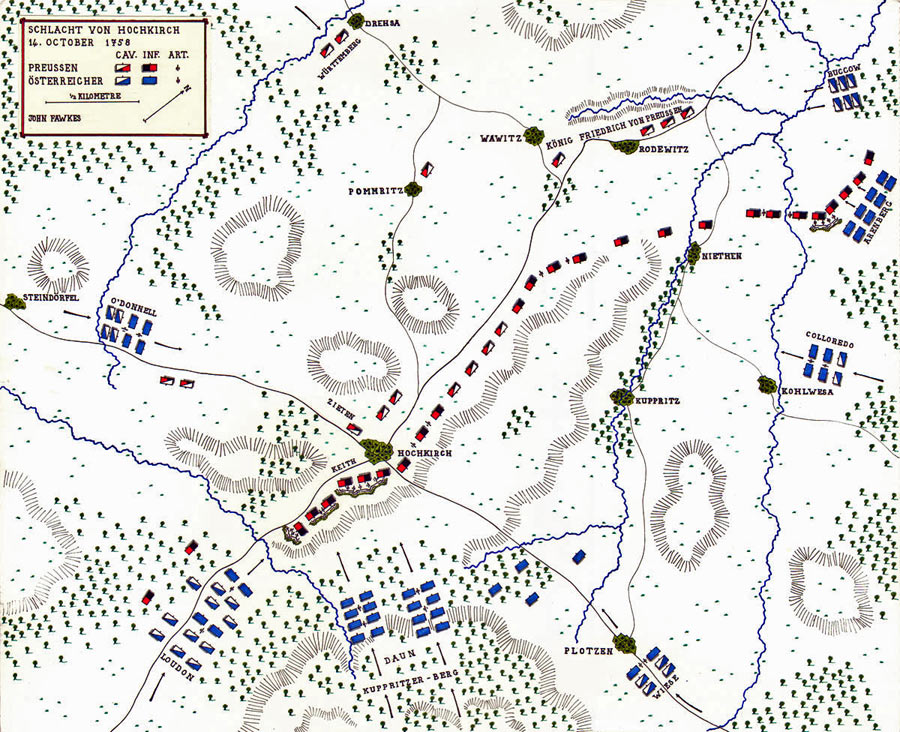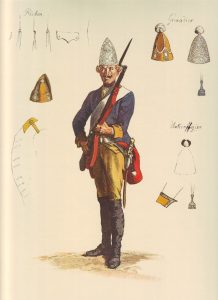Frederick’s defeat at the hands of the Austrians on 14th October 1758

Austrian troops sack the Prussian camp at the Battle of Hochkirch on 14th October 1758 in the Seven Years War: picture by La Pegna
The previous battle in the Seven Years War is the Battle of Zorndorf
The next battle in the Seven Years War is the Battle of Kunersdorf
Battle: Hochkirch
Date of the Battle of Hochkirch: 14th October 1758
Place of the Battle of Hochkirch: In Eastern Saxony.
War: The Seven Years War.
Contestants at the Battle of Hochkirch: Prussians against an Imperial Austrian Army comprising the various nationalities that made up the Austrian Army (Austrians, Hungarians, Bohemians, Silesians, Croats, Italians and Moravians).
Generals at the Battle of Hochkirch: King Frederick II of Prussia commanding the Prussian Army against Marshal Daun commanding the Austrian Army.
Size of the Armies at the Battle of Hochkirch: Prussians: 20,000 infantry, 10,000 cavalry and 200 guns. Austrians: 50,000 infantry, 28,000 cavalry and 340 guns.
Winner of the Battle of Hochkirch: The Austrians, decisively.
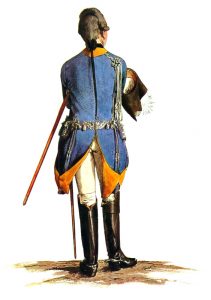
Prussian Dragoner-Regiment von
Stechow No 11: picture by Adolph Menzel as part of his series of pictures ‘Die Armee Friedrichs des Grossen in ihrer Uniformierung’
Uniforms and equipment at the Battle of Hochkirch:
The Prussian infantry and artillery wore a dark blue coat turned back at the lapels, cuffs and skirts, with britches and black thigh length gaiters. Each soldier carried on a cross belt an ammunition pouch, bayonet and ‘hanger’ or small sword. Headgear for the line companies was the tricorne hat, with a flattened front corner, bound with white lace. Grenadiers wore the distinctive mitre cap with a brass plate at the front. Fusilier infantry regiments and artillery wore a smaller version of the grenadier cap.
The infantry carried a musket as the main weapon. This single shot firearm could be loaded and fired by a well trained soldier around 3 to 4 times a minute. As an early improvement Frederick introduced the iron ramrod and then the reversible ramrod (the soldier did not have to worry whether he had the ramrod the right way round) which increased the rate of fire of his infantry, the old wooden ramrod being liable to break in the stress of battle.
The Prussian infantry regiment was based on the cantonment with soldiers joining their local regiment. In peacetime soldiers were released for key agricultural times, sowing and harvesting. In the autumn, reviews were conducted of all regiments to check they were up to the required standard. Each year regiments were selected to undergo review at Potsdam under the eye of the King. Officers whose soldiers’ performance was considered by Frederick to be substandard were subject to a public tongue lashing and in extreme cases dismissal on the spot.
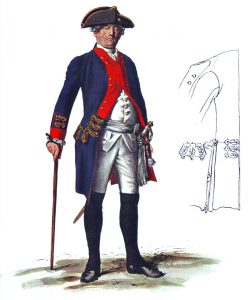
Prussian Infantry Regiment von Geist
No 8: picture by Adolph Menzel as part
of his series of pictures ‘Die Armee
Friedrichs des Grossen in ihrer Uniformierung’
The efficiency of the Prussian regiments at drill enabled them to move about the battlefield with a speed and manoeuvrability that no other European Army could equal. The Battle of Rossbach is a striking example of this facility.
During the peace between the sets of wars Frederick devised and practised his ‘oblique’ formation in attack. The technique was to deliver an assault on the flank of an enemy army. The Prussian infantry battalions would advance to the attack ‘in echelon’, or each battalion, after the leading battalion, setting off 50 paces after its predecessor. The Battle of Leuthen was the only battle in which Frederick was able to deliver a complete ‘oblique’ attack and did so with devastating success.
Heavy cavalry of the period comprised cuirassiers and dragoons. The Prussian cuirassiers wore a white coat, steel cuirass, white britches and thigh boots. Prussian Dragoons wore a light blue coat. The headgear was a tricorne hat. Weapons were a heavy cavalry sword and single shot flintlock carbine.
The light cavalry arm was provided by the Prussian Hussar regiments. The true hussars were Hungarians in the Austrian service. The hussars of other armies were given the same dress as the original hussars and required to perform a similar light cavalry role of reconnaissance and harassing the enemy’s outposts and supply columns.
Following the Battle of Mollwitz and in particular after the First Silesian War the Prussian Hussars were re-organised and re-trained to provide an efficient scouting and light cavalry service. Frederick found in Colonel von Zieten the ideal officer to implement the improvements in the hussar regiments. The Prussian Hussars wore the traditional hussar dress of tunic, britches, dolman (slung jacket), busby (fur hat) with bag, sabretache (leather wallet on straps hanging from the belt) and curved sword.
Unlike the original Hungarian Hussars of the time who were considered to be little more than indisciplined freebooters the Prussian Hussars were well able to take a position in the cavalry line and perform valuable service in battle, as at the Battle of Hohenfriedburg and on other occasions.
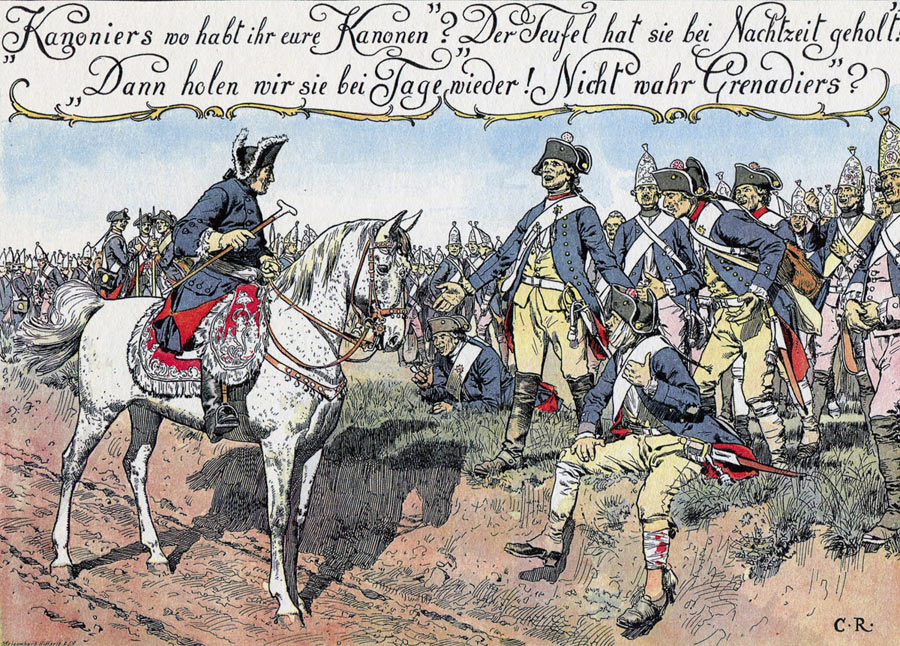
Frederick the Great addresses Prussian gunners after the Battle of Hochkirch 14th October 1758 in the Seven Years War: picture by Carl Röhling
The Austrian infantry wore white coats with lapels, cuffs and skirts turned back showing the regimental lining colour. Headgear was the tricorne hat for line infantry and bearskin cap for grenadiers. The infantry weapons were musket, bayonet and hanger small sword. Heavy cavalry wore white coats and hats as for the infantry and were armed with a heavy sword and carbine. The Austrian army contained a large number of irregular units such as the Pandours from the Balkans who wore their ethnic dress without uniformity. Hungarian Hussars provided the light cavalry arm. These Hussars, dressed as described for the Prussian Hussars, were considered to be little more than bandits but were highly effective in all the roles required of light cavalry.
The artillery of each army was equipped with a range of muzzle loading guns.
Frederick implemented significant improvements to the Prussian Army between the two Silesian wars. The eleven years of peace before the Seven Years War enabled Frederick to bring the various arms of the Prussian service to a further high pitch of efficiency. Each year the regiments were subjected to a training cycle that culminated in reviews at Potsdam under the King’s exacting eye. Autumn manoeuvres were held in Silesia, the area where much of the expected warfare would be conducted (see the benefit of these manoeuvres at the Battle of Leuthen).
The Prussian infantry was a tested and established asset and required little improvement. Most of the innovation was targeted at the cavalry, artillery and technical arms.
One unfortunate development from the Silesian Wars was that Frederick formed the view that his infantry could win their battles simply by the steadiness of their advance. The Seven Years War began with the Prussian infantry doctrine being to advance with muskets at the shoulder and not to pause to fire on the enemy. The Battle of Prague showed this doctrine to be badly misguided and it was abandoned after causing the Prussians substantial casualties.
The Prussian infantry was soon trained to advance making brief halts to fire and reload, enabling it to deliver successive volleys as it marched up to the opposing army, a technique used to devastating effect at the Battle of Rossbach.
During the course of the Seven Years War Frederick extensively re-organised the artillery. New equipment was introduced, the guns standardised and the artillery formations overhauled. Frederick introduced horse artillery that could move around the battlefield.
Frederick brought the Prussian cavalry to a level of effectiveness unrivalled by any other European Army of any period. The basic requirement was a high standard of horsemanship in every soldier. A trooper was required to ride his horse every day, an exacting obligation in peacetime. Contrast this with the practice of the British regiments of horse and dragoons of the time, in which as a measure of economy the horses had their shoes struck off and were put out to grass unridden for the whole of the summer (see Viscount Molesworth’s standing orders for his dragoon regiment).

Frederick the Great at the Battle of Hochkirch 14th October 1758 in the Seven Years War: picture by Adolph Menzel
Every year Frederick exercised the cavalry during the autumn manoeuvres. Frederick required the cuirassier and dragoon regiments to form line at the gallop and deliver a charge, with the troopers so close that they rode knee behind knee with the horses touching. Frederick developed the capability of the cavalry year by year. Finally he required his mounted regiments to be able to deliver three such charges one after the other at full gallop.
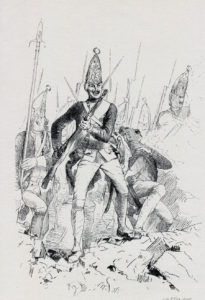
Prussian Guard Grenadiers: Battle of Hochkirch 14th October 1758 in the Seven Years War: print by Adolph Menzel
The effect of this exacting training was graphically illustrated by the performance of the Prussian cavalry force led by General von Seydlitz against the Russians at the Battle of Zorndorf on 25th August 1758. Seydlitz’s squadrons crossed the Zabern-Grun stream, climbed the steep far bank and moved through an area of scrub, before forming two lines of hundreds of troopers at the gallop, so close together that the horses were touching, and delivering a devastating charge at full gallop against unshaken Russian infantry, who were overwhelmed. Against cavalry of this quality it mattered little whether the infantry was in line or square.
This extraordinary ability contrasted with most other European cavalry regiments which would form for the charge at the halt and then attack in a loose formation which would be lost in the course of the charge, ending with the horses blown and all cohesion gone. If the infantry under attack seemed unduly aggressive, the attacking cavalry would be liable to swerve around them or pull up.
It was Frederick’s order that any Prussian cavalry commander receiving a charge at the halt would be tried by court-martial. Commanders had the discretion to attack if they considered that a favourable opportunity existed, without waiting for orders.
The Battle of Rossbach is another good example of the quality of the Prussian heavy cavalry and its ability to deliver battle winning charges through remaining under the tight control of its commander.
Background to the Battle of Hochkirch: In 1758 King Frederick II of Prussia and his armies held Silesia and much of Saxony. In the mid-summer of 1758 Frederick hurried to confront the Russian incursion to the Oder leaving his brother Henry to oppose the Austrians of Marshal Daun and the Reichsarmée of Prince Zweibrucken in Saxony. Daun planned an attack on Prince Henry but acted so slowly that Frederick had defeated the Russians at Zorndorf on 25th August 1758 and raced back to Saxony before the Austrian / Reichsarmée got under way.
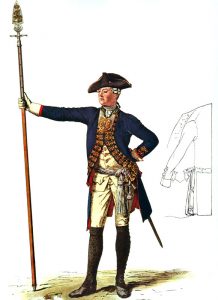
Prussian Infantry Regiment Markgraf Karl No 19: picture by Adolph Menzel as part of his series of pictures ‘Die Armee Friedrichs des Grossen in ihrer Uniformierung’
Daun’s army occupied the hills outside Dresden at Stolpen while Frederick held Dresden and encamped on the lower ground.
Frederick moved his army towards Silesia with the intention of forcing Daun to withdraw south into the Austrian province of Bohemia. Contrary to expectations Daun moved east to Kittlitz where he established a fortified encampment on 7th October 1758.
On 10th October 1758 the Prussian army arrived in the area of the Saxon town of Hochkirch where Frederick intended to wait for supplies from Bautzen before moving on into Silesia. A feature of Hochkirch was its substantial and ornate newly built church.
The Prussian army’s position formed a long shallow S shape stretching from Hochkirch to the village of Rodewitz to the North East. Further to the North the detached Prussian force of General Retzow, comprising 9,000 men, was encamped at Weissenberg.
A redoubt guarded the Prussian left and a series of redoubts formed the right of the Prussian position beyond Hochkirch. The weakness of the Prussian right was that it was overlooked by the Kuppritzer Berg, heavily wooded high ground dominated by the numerous Austrian Croat light troops.
It was this weakness that the Austrian General Lacy urged his commander, Marshal Daun to exploit. Daun conducted careful reconnaissance of the Prussian position over a period of days before accepting Lacy’s recommendations for a full attack. Lacy was left to plan the assault which was set to commence at 5am by the striking of the Hochkirch church clock on 14th October 1758.
Account of the Battle of Hochkirch:
On the night before the attack the Austrians left their tents standing and camp fires burning. Workmen continued felling trees for an abattis to defend the Austrian camp and were encouraged to sing and call out loudly.
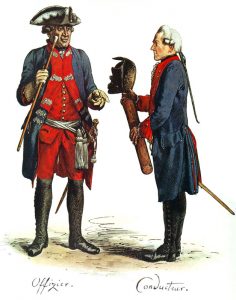
Prussian Engineers: picture by
Adolph Menzel as part of his series
of pictures ‘Die Armee Friedrichs des Grossen in ihrer Uniformierung’
On the day of the assault the area was covered by a thick early morning fog. The main Austrian assault, led by Daun himself, emerged from the wooded Kuppritzer Berg to attack the Prussian batteries in the redoubts to the South of Hochkirch. Although 2 Prussian free battalions were in the forest no advance warning was given to the Prussian line, such was the all enveloping effect of the terrain and the activities of the Croat light infantry.
A strong cavalry force led by General von Loudon advanced up the road from the South towards Hochkirch to the left of Daun. A further force under General O’Donnell advanced along the road from the West directly into the rear of the Prussian right wing. General Weisse approached Hochkirch from the opposite direction. 4 separate Austrian contingents were converging on the Prussian positions in and around Hochkirch in overwhelming strength.
The Prussian commanders in the area of Hochkirch were Marshal Keith and General Zieten.
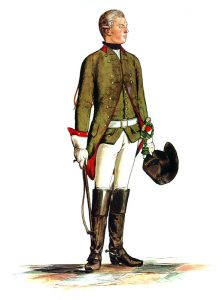
Prussian Mounted Field Jӓger: picture by Adolph Menzel as part of his series of pictures ‘Die Armee Friedrichs des Grossen in ihrer Uniformierung’
Daun’s main body emerged from the woods on the hillside, disappearing into the dead ground to the front of the Prussian redoubts before delivering an attack which quickly overwhelmed the defenders and captured the battery in the end redoubt.
Frederick’s quarters were in the village of Rodewitz at the far end of the Prussian line. Signal rockets could be seen in the sky and heavy firing heard, but Frederick’s staff could not persuade him that a major attack was under way and that he should rise to deal with it. Frederick’s view was that the Austrian Croat light troops were responsible for a harassing fire every morning and that there was nothing unusual about the firing that could be heard that day.
A Captain von Troschke arrived with the news that the Austrians had taken the end redoubt of the Prussian position and were attacking towards Hochkirch. Frederick was sceptical until Troschke informed him that the Austrians would soon be firing on him with his own guns. At that moment the first salvo screamed over their heads and Frederick commented “Troschke, you are quite right. Lads, take up your muskets. Somebody find my horse.”

Field Marshal James Keith, Frederick the Great’s general,
killed at the Battle of Hochkirch
on 14th October 1758 in the Seven Years War
In the area of Hochkirch the Prussians were struggling to hold the Austrians back, the most savage fighting being centred on the church. The second battalion of Margrave Carl’s Regiment (No 19) under Major Simon Moritz von Langen held the churchyard wall while the remaining Prussian infantry regiments crammed into the town in considerable disorder.
General Zieten directed General Krockow to deliver a charge with the Schönach Cuirassiers against the Austrian infantry which ensured a short reprieve. Krockow was fatally wounded in the charge from which the cuirassiers returned with an Austrian colour and some 50 Austrian prisoners.
In the meantime Marshal Keith directed counter attacks against the advancing Austrian regiments.
While leading the Regiment Prinz von Preussen (No 18) Keith was shot dead from his horse.
Another of Frederick’s leading generals Moritz of Anhalt-Dessau was severely wounded in the battle and permanently incapacitated.
One of the streets of Hochkirch was so full of dead and wounded Prussian soldiers that after the battle it was named the ‘Blutgasse’ or ‘Blood Street’.
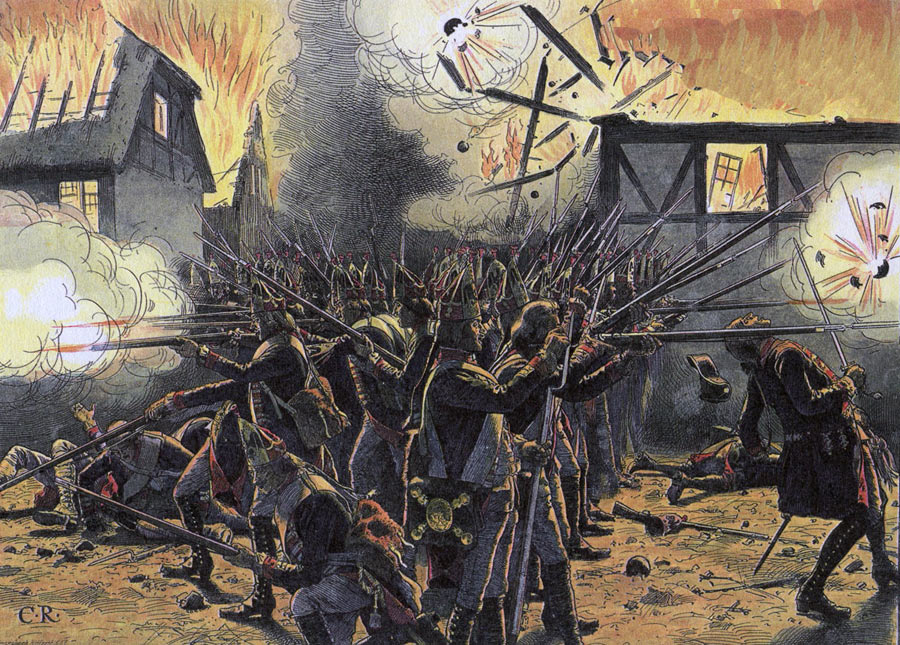
Prussian infantry at the Battle of Hochkirch 14th October 1758 in the Seven Years War: picture by Carl Röhling
As Daun pressed his attacks on the Prussians in and around Hochkirch further Austrian forces under Generals Arenburg and Buccow attacked the far end of the Prussian line. The great battery in front of Rodewitz was taken and the Prussian infantry driven out in flight. Another Austrian force under General Colloredo advanced towards the Prussian centre. Frederick had allowed his army to be taken completely by surprise by the substantially more numerous army of Marshal Daun.
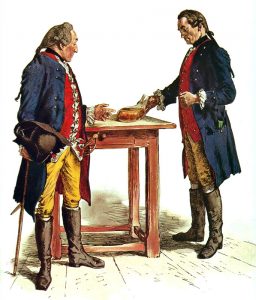
Prussian surgeons: picture by Adolph Menzel as part of his series
of pictures ‘Die Armee Friedrichs des Grossen in ihrer Uniformierung’
Frederick made his way to Hochkirch where it became clear that there must be an immediate withdrawal in order to save his army. The retreat was effected with the Prussians drawing off to the North West. This difficult operation was eased by the failure of the Austrian generals attacking the Prussian left flank to move with sufficient aggression in pursuit of Frederick’s defeated and demoralised troops.
The Prussian retreat was covered by a rearguard assembled around the Regiment of Alt-Braunschweig (No 5) and commanded by Lieutenant Colonel Saldern.
As soon as he realised the extent of the Austrian attack Frederick sent an urgent message to General Retzow requiring him to join the main army. Retzow was delayed in responding to this order as he had come under attack. As soon as he was able Retzow marched his force to the sound of the fighting. Prince Eugene of Würtemburg, commanding Retzow’s cavalry, hurried in advance and assisted in covering the Prussian retreat.
Frederick gathered his troops at Dobershütz, where he took stock of the disaster that had engulfed his army.
Daun failed to follow up his signal victory over the Prussians.
Casualties at the Battle of Hochkirch: Prussian losses: 9,100 men killed, wounded and captured and 101 guns lost. Austrian losses: 7,000 men killed, wounded and captured.

Death of Field Marshal James Keith at the Battle of Hochkirch 14th October 1758 in the Seven Years War
Aftermath to the Battle of Hochkirch:
Frederick was thrown into a period of depression by the battle.
On 20th October 1758 Frederick’s brother Prince Henry joined him with reinforcements.
Ever cautious Daun failed to exploit his victory and gave Frederick the breathing space he needed to re-constitute and re-organise his defeated army. Frederick withdrew into Silesia while Daun returned to the siege of Dresden. The Prussian commander in Dresden, Count Schmettau, was an officer of determination and prepared the city for a siege, burning the outer suburbs so that the fortifications were cleared. In November 1758 Frederick advanced to Dresden and Daun withdrew into the hills.
Anecdotes from the Battle of Hochkirch:
- Carlyle puts forward the story that there was a Prussian agent in the Austrian camp who was discovered and turned by the Austrians. The message sent to Frederick by the agent (in an egg, it is said) had it that the Austrians were about to retreat.
- The most striking individual loss in the battle for Frederick was the death of Field Marshal James Keith. Keith was a Scottish Jacobite fugitive from Prince Charles Edward Stuart’s ’45 rebellion. Keith served in the Russian Army before moving to the Prussian service. Frederick quickly promoted Keith to the highest rank. The Austrians found Keith’s body stripped naked on the battlefield. Keith was moved to the church in Hochkirch where he was recognised by General Lacy whose father had served with Keith in the Russian army. Keith was buried by the Austrians with full military honours. Keith’s brother served as the Prussian ambassador to the Court of King Louis of France. Such was the esteem that Frederick held the Keith brothers that he arranged with King George II for the return of the Keith’s estates in Scotland sequestered for their involvement in the ‘45. The Keith family provided the hereditary Earl Marischal to the King of Scotland. A Keith commanded the small force of Scottish horse at the Battle of Bannockburn in 1314.
- Keith expressed the view before the battle that “the Austrians deserve to be hanged if they do not attack us here (Hochkirch)”.
- Frederick suffered a further blow after the battle with the news of the death of his beloved sister Wilhelmine.
- Another Prussian casualty was the brother of Frederick’s Queen, Prince Franz of Brunswick who was beheaded by a cannon shot.
- Frederick was well aware that he held full responsibility for the disaster. The British Ambassador Mitchell, who accompanied the Prussian Army, attributed the Prussian defeat to Frederick’s deep contempt for the Austrians and his inability to accept information that went contrary to his own assessment of a situation. The Prussian General Warnery commented that Frederick would never have tolerated such neglect in one of his subordinates.
References for the Battle of Hochkirch:
- Frederick the Great by Thomas Carlyle
- Frederick the Great by Christopher Duffy
- The Army of Frederick the Great by Christopher Duffy
- The Army of Maria Theresa by Christopher Duffy
The previous battle in the Seven Years War is the Battle of Zorndorf
The next battle in the Seven Years War is the Battle of Kunersdorf
